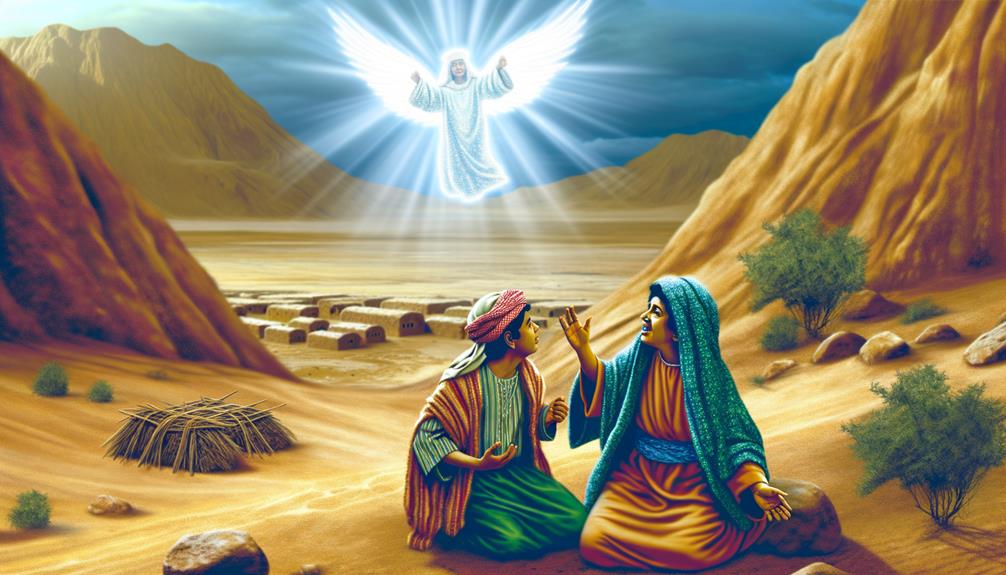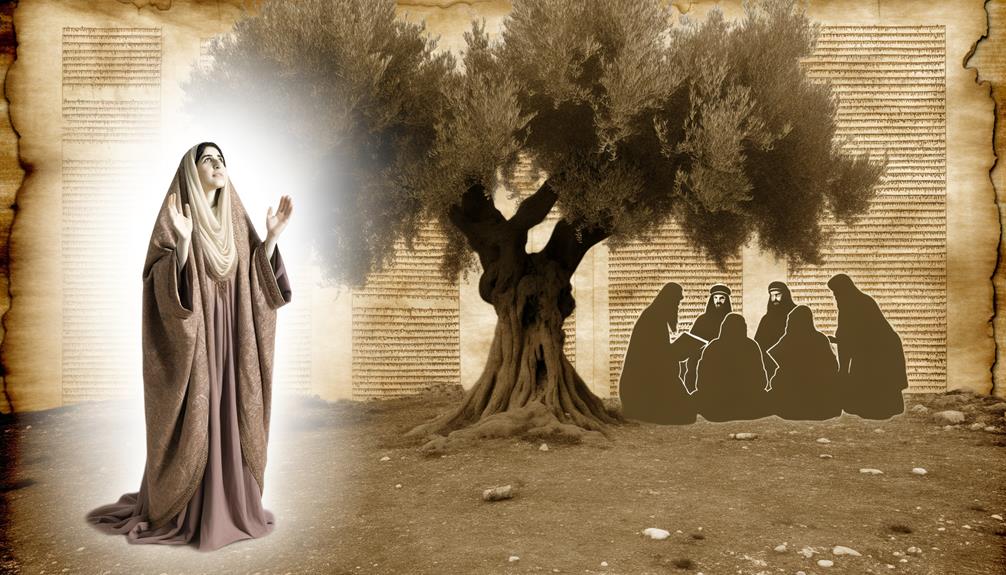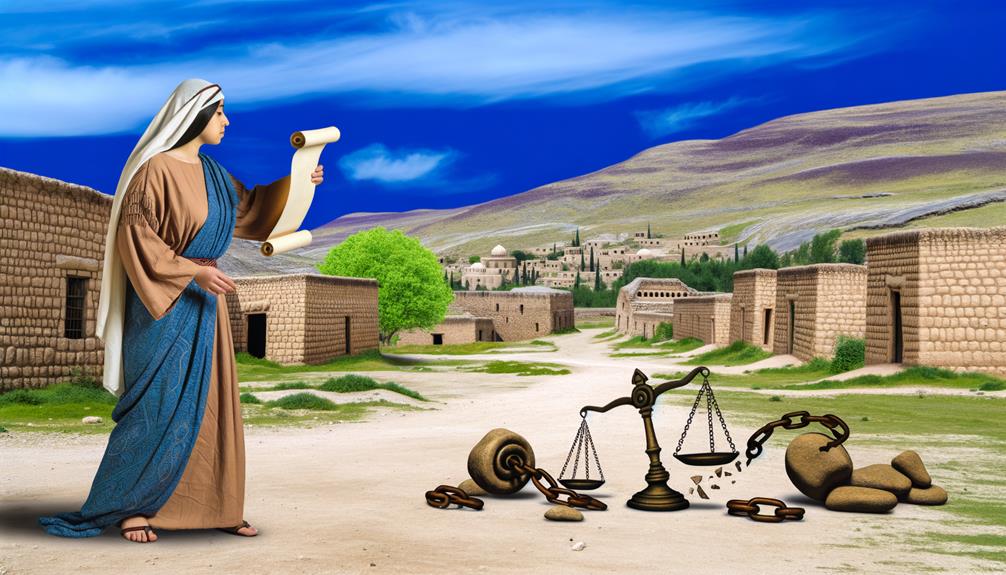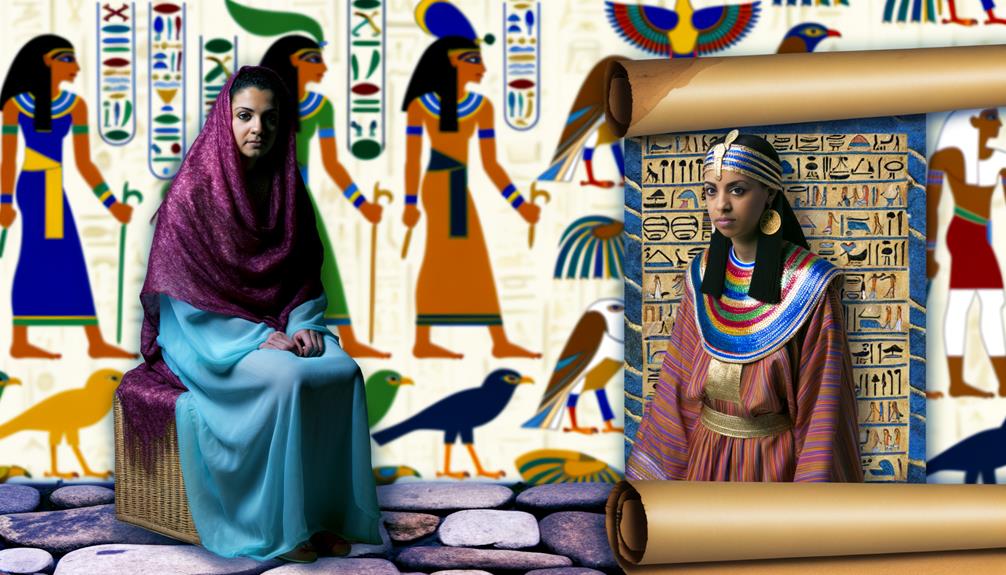Bondwoman Meaning in the Bible: Servitude and Lessons
In biblical texts, a bondwoman is a female slave bound to serve her master, a role that encompasses domestic work and, at times, childbearing. Figures like Hagar, Zilpah, and Bilhah illustrate the complex interplay of servitude, familial dynamics, and divine interactions within household hierarchies.
Legal provisions like those in Exodus and Deuteronomy address the rights and eventual release of bondwomen, underscoring a blend of social stratification and religious ethics. The New Covenant, through Pauline writings, reinterprets their status, emphasizing spiritual liberation, symbolizing broader notions of justice and equality.
Further examination reveals deeper ethical and theological dimensions.

Bondwoman Meaning in the Bible: Definition and Spiritual Significance
| Aspect | Details |
|---|---|
| Definition | A female slave or servant, often bound in service or ownership |
| Key Bible Reference | Hagar, the bondwoman of Sarah (Genesis 16, 21) |
| Symbolic Meaning | Represents the old covenant or life under the law (Galatians 4:22-31) |
| Spiritual Insight | Contrast between bondage (law) and freedom (grace) |
| Moral Lesson | Servitude may reflect spiritual captivity, while freedom aligns with God’s promise |
Definition of a Bondwoman

In biblical context, a bondwoman, also referred to as a handmaid or maidservant, is a female slave who is legally bound to serve her master or mistress. This designation signifies not only a lack of personal freedom but also a specific role within the household or community hierarchy.
The term often implies a complex relational dynamic, where the bondwoman’s duties could range from domestic chores to more intimate responsibilities, such as bearing children for her master. Such a position is heavily influenced by cultural, economic, and legal factors of the time, reflecting broader societal norms regarding gender and servitude.
Understanding the status and functions of bondwomen provides essential insights into the social structures and moral frameworks within biblical narratives.
Old Testament References

The Old Covenant presents numerous references to bondwomen, each instance shedding light on the varied roles and significances of these women within ancient Israelite society. These references not only depict the social and economic dimensions of servitude but also the complexities of familial and divine relationships.
- Hagar (Genesis 16): Hagar, Sarah’s Egyptian maidservant, becomes Abraham’s concubine and bears Ishmael, symbolizing themes of promise and exile.
- Zilpah (Genesis 30:9-12): As Leah’s maid, Zilpah bears children to Jacob, highlighting the practice of surrogacy and the extension of family lineage.
- Law of Release (Exodus 21:7-11): Regulations surrounding the treatment and eventual release of bondwomen emphasize justice and humane treatment within the legal framework.
These narratives collectively reveal the multifaceted roles bondwomen played.
New Testament Context

Exploring the New Covenant context, one discovers a nuanced evolution in the portrayal and significance of bondwomen, reflecting broader theological and social paradigms of the early Christian community.
In the New Scripture, the concept of liberation through Christ becomes pivotal. Galatians 4:22-31 allegorically contrasts the bondwoman Hagar and the free woman Sarah to illustrate the change from the old Law to the freedom found in Christ. This shift underscores a spiritual emancipation rather than a mere social reformation.
Additionally, the early Christian ethos, as seen in Paul’s epistles, emphasizes equality in Christ (Galatians 3:28), subtly challenging the existing social hierarchies and reinterpreting the roles of bondwomen within the newfound spiritual freedom of the burgeoning Christian faith.
Key Biblical Figures

Frequently, key biblical figures such as Hagar and Sarah serve as pivotal archetypes in understanding the multifaceted role and symbolism of bondwomen within the scriptural narrative. Their stories illuminate various dimensions of servitude, divine promise, and human struggle.
- Hagar: An Egyptian maidservant to Sarah, Hagar’s relationship with Abraham and the subsequent birth of Ishmael underscore themes of obedience, exile, and divine intervention.
- Sarah: As Abraham’s wife, Sarah’s interactions with Hagar reveal the complexities of power dynamics, jealousy, and God’s providential plans.
- Leah and Rachel’s Maidservants: Bilhah and Zilpah, who bore children for Jacob, illustrate how the status of bondwomen could be elevated in certain familial and tribal contexts.
These narratives collectively contribute to a richer understanding of the biblical portrayal of bondwomen.
Social Status and Roles

Understanding the social status and roles of bondwomen in biblical times requires a thorough examination of the intersecting factors of culture, law, and theology.
Bondwomen, often acquired through conquest or economic transactions, occupied a lower social stratum within ancient Israelite society. Their roles extended beyond mere labor; they were integral to household economies, often performing domestic tasks and sometimes serving as concubines or secondary wives.
The theological framework of the period, influenced by patriarchal norms, further shaped their societal positioning. While bondwomen were afforded certain protections under Mosaic Law, their status was inherently tied to their lack of autonomy and subjugation to their masters.
This complex interplay underscores the multifaceted nature of servitude in biblical contexts.
Legal Aspects of Servitude

How did the legal frameworks of ancient Israel delineate the boundaries and obligations of servitude within their societal construct?
The legal codices, particularly those found in Exodus, Leviticus, and Deuteronomy, provided a structured approach to servitude. These texts outlined specific statutes to guarantee a regulated and, by their standards, just system.
Key elements included:
- Duration of Service: Enslaved Hebrews were to be released after six years of service (Exodus 21:2).
- Rights and Protections: Masters were obliged to provide for their servants’ basic needs and were restricted in their treatment (Leviticus 25:39-43).
- Manumission Conditions: Certain conditions allowed for the liberation of bondwomen, such as marriage to a free man (Deuteronomy 21:10-14).
These laws aimed to balance social order with ethical considerations.
Theological Implications

In examining the theological implications of servitude within the Biblical narrative, it becomes evident that the institution of bondwoman status was intricately connected to broader themes of covenant, redemption, and divine justice.
The role of bondwomen, such as Hagar, underscores the complex interplay between human agency and divine will. Hagar’s story, for instance, highlights God’s providence and mercy, as she received divine promises despite her subordinate status. This narrative arc reflects the broader theological motif wherein God’s plans transcend societal norms, revealing a divine justice that upholds the marginalized.
Additionally, the covenantal aspects illustrated through the lives of bondwomen serve as a proof of God’s inclusive promise, encompassing all, regardless of social standing, within the redemptive scope.
Ethical Considerations

Examining the ethical considerations surrounding the term ‘bondwoman’ in the Bible requires an analysis of the moral implications, particularly how these narratives influenced societal norms and individual behaviors.
It is essential to contextualize these implications within the historical period to understand the complexities of human dignity and the inherent value assigned to individuals in these texts.
In addition, addressing the ethical dimensions highlights the enduring relevance of these discussions in contemporary debates on human rights and social justice.
Moral Implications Explained
The moral implications of the term ‘bondwoman’ in the Bible necessitate a thorough examination of the socio-cultural and ethical contexts in which these women lived and were subjugated. Understanding these implications involves several key deliberations:
- Human Dignity: Bondwomen were often stripped of their intrinsic human rights and dignity, raising questions about the ethical treatment of individuals regardless of their societal status.
- Gender Roles: The subjugation of bondwomen underscores the entrenched gender inequalities of biblical times, highlighting the moral challenges in patriarchal societies.
- Social Justice: The Bible’s narratives about bondwomen prompt reflection on the broader issues of social justice and equity, urging contemporary readers to contemplate the historical injustices and their ongoing impact.
Each aspect invites a deeper ethical reflection on the term ‘bondwoman’.
Historical Context Matters
Understanding the ethical considerations surrounding the term ‘bondwoman‘ requires a meticulous exploration of the historical context in which these women existed.
In the biblical era, a bondwoman was often a female servant or slave, bound by social, economic, and legal constraints unique to the times. This status, while seemingly clear-cut, was laden with complexities, including varying degrees of autonomy, rights, and societal roles.
Examining these intricacies is essential for comprehending the ethical dimensions of their portrayal and treatment. The historical context reveals a spectrum of experiences, illustrating how socio-economic structures and cultural norms shaped their lives.
Human Dignity Concerns
A critical analysis of human dignity concerns related to the term ‘bondwoman’ in the Bible necessitates an exploration of the ethical implications of their treatment and societal roles. The biblical depiction often places bondwomen in subservient positions, raising significant ethical questions about their autonomy and inherent worth.
This analysis can be broken down into three key areas:
- Legal Status: Bondwomen often lacked legal rights, impacting their ability to seek justice and protection.
- Social Hierarchy: Their roles reinforced societal structures that marginalized them, perpetuating inequality.
- Moral Responsibility: The ethical duty of those in power to treat bondwomen with dignity, despite prevailing norms.
Understanding these dimensions provides insight into the complexities of human dignity within biblical contexts.
Comparative Cultural Views

Examining the role of bondwomen across various ancient cultures reveals significant differences in social status, legal rights, and societal expectations, offering a rich context for understanding their portrayal in biblical texts.
In Ancient Mesopotamia, bondwomen were often integrated into households with specific duties but had limited legal protections.
Conversely, Egyptian society allowed for more fluid social mobility, with some bondwomen acquiring property or attaining freedom.
Greco-Roman practices varied, with bondwomen sometimes engaged in economic activities or personal service, yet they remained subject to their owners’ authority.
These diverse cultural frameworks illuminate how biblical references to bondwomen, such as Hagar in Genesis, can be understood within a broader historical and societal milieu, reflecting varying degrees of agency and restriction.
Modern Interpretations

Frequently, modern interpretations of the term ‘bondwoman’ in biblical texts are shaped by contemporary socio-cultural perspectives, which endeavor to reconcile ancient narratives with present-day values on human rights and gender equality. Scholars and theologians often explore the implications of this term to understand the historical context and its significance in today’s world.
These interpretations typically address:
- Historical Context: Analyzing the socio-economic conditions that defined the bondwoman’s role, shedding light on systemic inequalities of the time.
- Symbolic Meaning: Understanding the bondwoman as a symbol for broader human experiences, such as subjugation and liberation.
- Ethical Relevance: Evaluating how biblical references to bondwomen inform current discussions on human rights and gender dynamics, promoting a more equitable worldview.
Such analyses help bridge ancient texts with modern ethical standards.
Conclusion
The term ‘bondwoman‘ in the Bible encapsulates complex social statuses, significant theological implications, and varied ethical considerations.
Examined through Old and New Scriptures lenses, the lives of key biblical figures highlight the evolving roles and perceptions of bondwomen.
Comparative cultural views and modern interpretations further enrich this multifaceted concept, revealing a historical narrative that intertwines bondage, faith, and societal norms.
Understanding the bondwoman’s role offers a profound glimpse into ancient and contemporary socio-religious dynamics.






